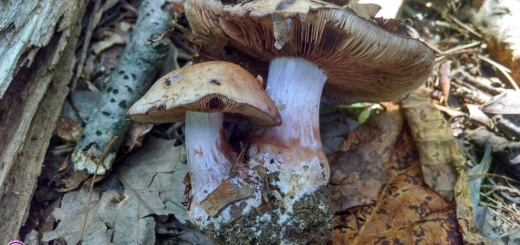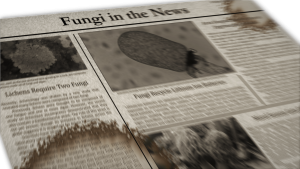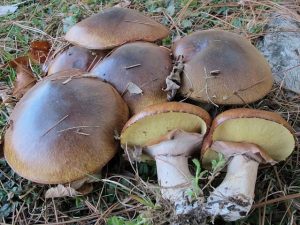#103: Grifola frondosa, The Hen of the Woods
This edible mushroom has a few common names, including: “Hen of the Woods,” “Sheepshead,” and “” It is parasitic on hardwood tree roots, so look for this mushroom around the bases of hardwoods (especially oaks and maples) in the fall.
The Hen of the Woods is a polypore that forms large rosettes composed of numerous, small fronds. Rosettes can grow up to 60cm (2 feet) across or more, but individual caps are only 2 to 10cm (1-4in). Each frond is fan-shaped with a wavy margin and arises from a common, branched stalk. The caps’ upper surface is gray to brown and smooth to nearly velvety. Underneath, the pore surface is lavender gray to white to yellowish and runs down the stipe almost all the way to the ground. The pores are small (2-4 per millimeter), angular, and leave a white spore print. The flesh of the mushroom is firm and white.
When cooked, the mushrooms resemble chicken meat, which gives the mushroom one of its common names. Additionally, the rosettes are said to resemble a hen sitting on her nest, thus suggesting the name “Hen of the Woods.” The name “Sheepshead” is also based on the rosettes, which look like the unruly hair on a sheep’s head (at least to a shepherd). The Japanese name for this mushroom is “Maitake,” which means, “Dancing Mushroom.” Supposedly, this is because people dance with joy upon finding Maitake. I must admit, this sounds like a perfectly reasonable reaction to such a lovely find!
The Hen of the Woods is a good edible. You can eat any of the fronds, but the stipe is less palatable. Still, collections of 10 pounds or more are common. You can often get a number of meals out of a single fruiting body! Since the Hen of the Woods grows parasitically on its host tree, you can usually find it year after year. I, however, have not been so fortunate. The one I found at UVA (at the base of an oak tree near Brown College) refused to reappear for me in subsequent years. Unfortunately for the tree, the Hen of the Woods damages the tree’s roots, which makes the tree more likely to be killed by wind or other stress factors.
Grifola frondosa can also be cultivated. Sawdust and other wood byproducts are sterilized, packed into plastic bags, and inoculated with G. frondosa mycelium. The sealed bags are allowed to sit for a couple months while the mycelium grows throughout the bag. At the end of this period, a hole is cut at the top of the bag. With the right concentration of oxygen and carbon dioxide – typically more oxygen and less carbon dioxide than normal air – the fungus will produce a fruiting body at the hole. This process is efficient but finicky.
G. frondosa is reported to have numerous health benefits and has been the subject of numerous scientific studies. The earliest reference to G. frondosa’s medicinal properties comes from the Chinese work Shen Nong’s Scripture of Herbal Medicine (Shen Nong Ben Cao Jing), which dates from between 200BCE to 200CE. G. frondosa is said to have a number of health benefits, including: relieving stomach pain, relieving nerve pain, calming nerves, treating hemorrhoids, treating arthritis, stimulating the immune system, and regulating homeostasis. Scientific studies have shown that the mushroom can boost immune function, alleviate hypertension, reduce cholesterol, reduce weight gain, treat symptoms of diabetes, and fight tumors. Its antitumor properties are most potent in an extract of the mushroom known as the D-fraction. This extract can be prepared by steeping a piece of the mushroom in hot water to make a kind of tea. There have not been any widespread clinical trials of G. frondosa extract, so many of these laboratory effects have not been verified.
This post does not contain enough information to positively identify any mushroom. When collecting for the table, always use a local field guide to identify your mushrooms down to species. If you need a quality, free field guide to North American mushrooms, I recommend Michael Kuo’s MushroomExpert.com. Remember: when in doubt, throw it out!
Do not use information in this post to self-diagnose or self-treat a medical complaint. Always consult a licensed medical doctor for proper diagnosis and treatment of a health issue.
See Further:
http://botit.botany.wisc.edu/toms_fungi/nov2006.html
http://www.messiah.edu/oakes/fungi_on_wood/poroid%20fungi/species%20pages/Grifola%20frondosa.htm








![#011: Characteristics of Kingdom Fungi [Archived]](https://www.fungusfactfriday.com/wp-content/themes/hueman/assets/front/img/thumb-small-empty.png)



2 Responses
[…] A picture on Facebook of the mushroom shows a beautiful Hen of the Woods (Grifola frondosa, FFF#103) with many fronds that could easily be mistaken for ruffled feathers. […]
[…] frondosa (Hen of the Woods, FFF#103) is the only mushroom similar to P. umbellatus. Like P. umbellatus, G. frondosa is a polypore […]